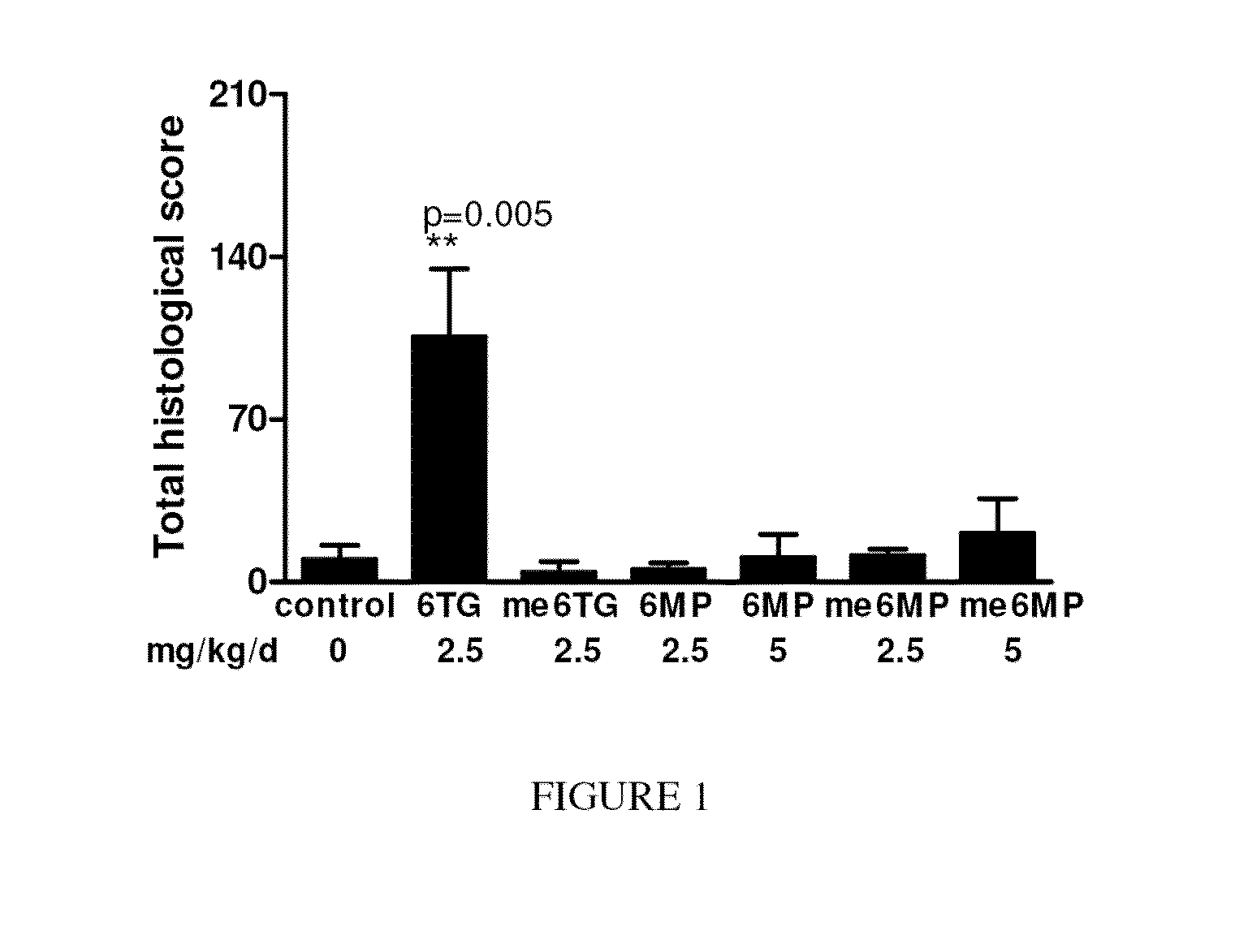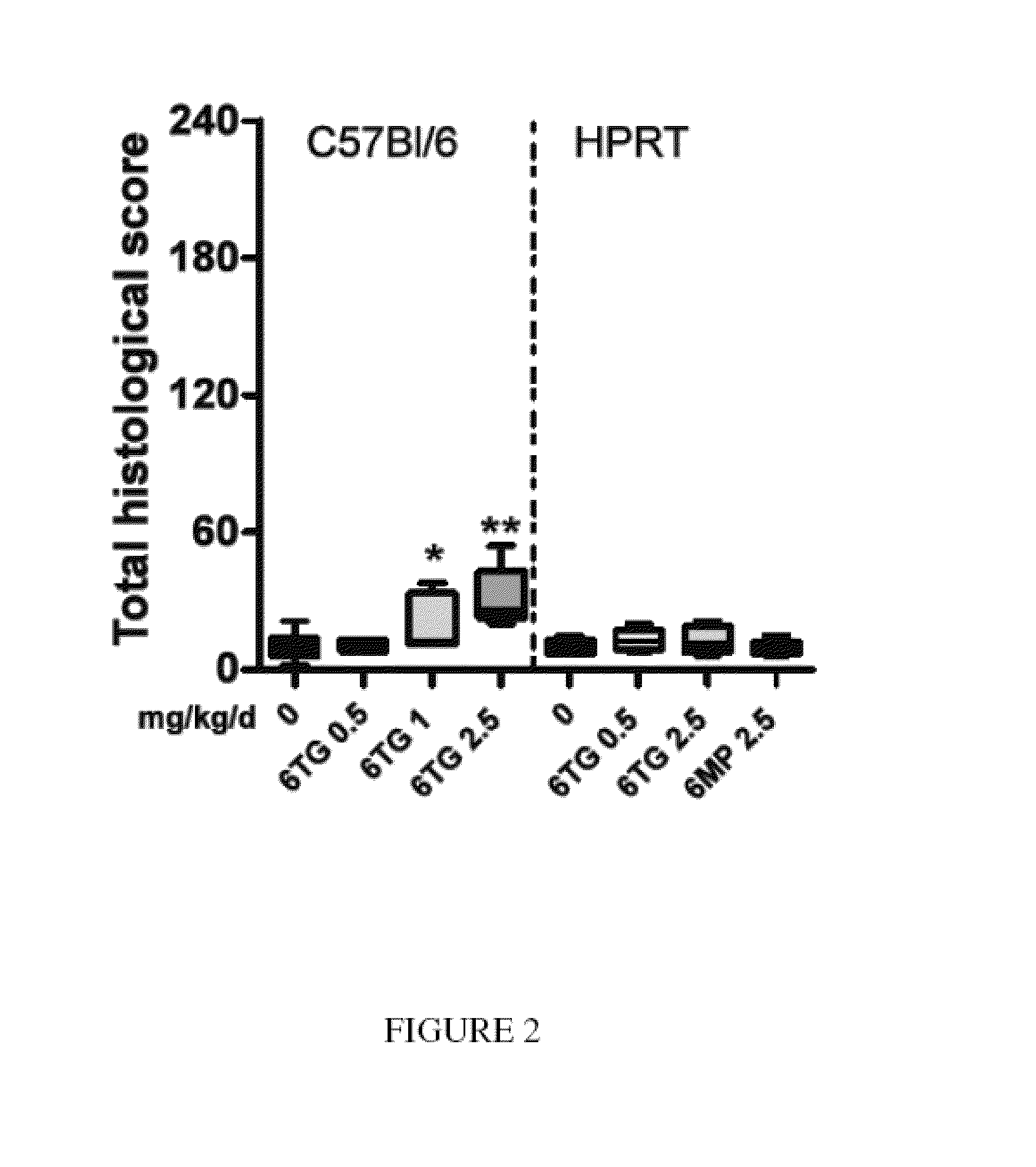Novel formulation and treatment methods
a technology of guanine and formulation, applied in the field of new formulations of guanine, can solve the problem that the less desirable methylated metabolites produced during the metabolism of 6-mp or aza are not produced, and achieve the effect of avoiding or reducing the side effects of 6-tg
- Summary
- Abstract
- Description
- Claims
- Application Information
AI Technical Summary
Benefits of technology
Problems solved by technology
Method used
Image
Examples
example 1
SOS (VOD) is Closely Associated with 6-TG
[0109]6-12 week old male or female C57BL / 6 mice were gavaged daily with 6-TG (2.5 mg / kg body weight / day) or 6-MP, (≦5 mg / kg body weight / day) methyl-6-MP (≦5 mg / kg body weight / day), or methyl-6-TG (≦2.5 mg / kg body weight / day) for 14 days.
[0110]Veno-occlusive disease (or “VOD”) in each mouse was scored in a blinded fashion based on predetermined scoring criteria for sinusoidal endothelial damage (maximum 60), hepatic central vein damage (maximum 60) and inflammatory cell infiltrates using haematoxylin-eosin sections counterstained with vWF for endothelial cells and F4 / 80 for macrophages (maximum 120). The total possible VOD score was 240.
[0111]The results are shown in FIG. 1 and demonstrated that SOS (VOD) was only observed in the mice treated with 6-TG. This experiment thus demonstrates that 6-TG, but not 6-MP or their methylated bases causes SOS in the mouse model used.
example 2
HPRT− / − Mouse Model
[0112]C57BL / 6 mice (n=6) and HPRT− / − C57BL / 6 mice (n=6) were administered various doses of 6-TG (0, 0.05, 0.2, 0.5, 1, 2.5 mg / kg body weight) by gavage each day for 14 days.
[0113]VOD was scored using the method described in Example 1.
[0114]The results are shown in FIG. 2 as box and whisker plots (median, quartiles and range) where * P≦0.05, ** P≦0.01, *** P≦0.005, Mann Whitney non-parametric tests. On the left hand side of the graph in FIG. 2, the results for the C57BL / 6 mice are shown. Dosages of 6-TG at 1 mg / kg body weight and above (both 1 mg / kg body weight and 2.5 mg / kg body weight) led to a VOD effect as shown. On the right hand side of the graph in FIG. 2, the results for the HPRT− / − C57BL / 6 mice are shown. VOD was shown to be abrogated at all dosage levels, including 1 mg / kg body weight and 2.5 mg / kg body weight.
[0115]These results indicate that HPRT− / − knockout mice administered 6-TG do not display SOS found in their wild-type counterparts. The metabolism ...
example 3
Intraperitoneal Dosage
[0116]Two groups of C57BL / 6 mice were administered a large bolus dose of 6-TG (2.5 mg / kg body weight / day) either (1) orally (by gavage) or (2) intraperitoneally for a period of 10 days.
[0117]VOD in each mouse was then scored using the method described in Example 1.
[0118]As shown in Examples 1 and 2, mice who received 6-TG at a dose of 2.5 mg / kg body weight / day for the 10 day period by oral gavage exhibited VOD. However, VOD was not observed in the second group of mice that received the same amount of 6-TG into the peritoneal cavity.
[0119]Intraperitoneal administration avoids the first pass portal circulation, and thus a substantially reduced amount of 6-TG (compared to the oral administration) would have reached the liver cells.
[0120]The results of this example thus show that it is the action of a high concentration of the thioguanine nucleotides on the liver cells (off-target cells) which induces the SOS (VOD / NRH) side-effect observed with conventional 6-TG th...
PUM
| Property | Measurement | Unit |
|---|---|---|
| sizes | aaaaa | aaaaa |
| body weight | aaaaa | aaaaa |
| body weight | aaaaa | aaaaa |
Abstract
Description
Claims
Application Information
 Login to View More
Login to View More - R&D
- Intellectual Property
- Life Sciences
- Materials
- Tech Scout
- Unparalleled Data Quality
- Higher Quality Content
- 60% Fewer Hallucinations
Browse by: Latest US Patents, China's latest patents, Technical Efficacy Thesaurus, Application Domain, Technology Topic, Popular Technical Reports.
© 2025 PatSnap. All rights reserved.Legal|Privacy policy|Modern Slavery Act Transparency Statement|Sitemap|About US| Contact US: help@patsnap.com


